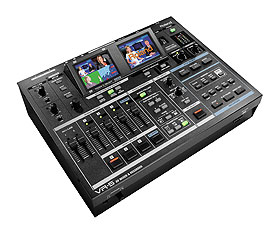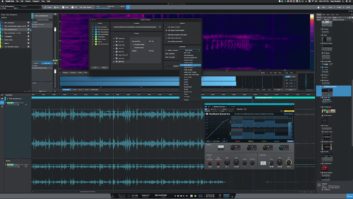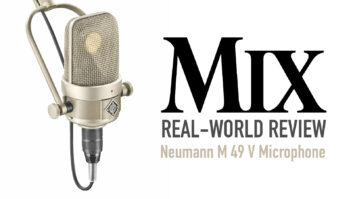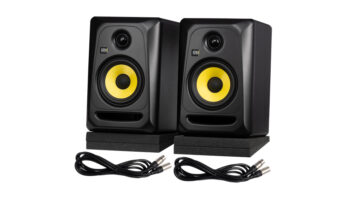
The boom in streaming video has opened up all kinds of new opportunities for audio professionals, and the tools are coming out to make quality audio-based video productions. Case in point: The Roland VR-5 provides a simple, one-box strategy for full-on, multi-camera video production with audio. The features not only negate needing a generous complement of hardware, but also a specialized set of skills and knowledge. With applications ranging from multi-camera capture of live events to live switching of video displays during concerts or church services, the VR-5 can capture a production to an SDHC card, generate live analog or HDMI video, or connect through USB to a computer for instant streaming on the Web.

The VR-5 provides a five-source video switcher, an audio mixer and an onboard player/recorder. Small LCDs for preview and program monitoring are built into the top of the unit. The video switcher is impressive on its own. Three different analog video sources can be connected with either BNC composite connections or S-Video 4-pin mini-DIN-style connectors. This obviously rules out the possibility of HD connections, and to that end, the unit is designed to operate in a maximum resolution of 480p. In addition to its video inputs, the VR-5 has a PC input using a 15-pin D-Sub-style connection. It can receive higher-definition resolutions (up to 1,600×1,200 at 60 Hz) but will automatically conform this to the native 480p operation inherent to the unit. Also, the unit can switch over to playback of files from the built-in SDHC card reader or the USB jack. While the five sources are toggled, the integrated frame synchronizer relieves you of any need to synchronize the refresh rates of the sources in advance, providing seamless switching between feeds.
Each of the five sources can include its own audio, with each of the video connections being accompanied by L/R RCA inputs, or 1/8-inch mini-TRS in the case of the PC input. Also, a separate pair of analog inputs are available, using ¼-inch TRS or XLR connections to accommodate either an additional pair of stereo lines or microphone signals. Each of these signals, as well as the audio output of the built-in player, feed an audio mixer featuring four stereo faders (sources 1 through 3 and the onboard player), two mono faders for the auxiliary inputs and a potentiometer to balance the PC input. The main output level control is also a potentiometer.
Along with the built-in video monitors, BNC-style outputs connect the program and the preview monitor to outboard displays. Secondary connectors for programs using BNC, S-Video and HDMI allow the finished product to run to an external recorder. These connections would also be useful in feeding the picture to a video matrix that feeds large in-house displays in a house of worship, for example. Meanwhile, audio outputs include the built-in headphone amplifier with a convenient connector and level control tucked neatly under the lip of the front edge. The program output simultaneously feeds a pair of unbalanced RCAs and balanced XLRs, and passes through the HDMI output. MP4 video with MP3 audio can be recorded to the integrated SDHC recorder at 480i/60 Hz or 576i/50 Hz in qualities ranging from 2 Mbps to 6 Mbps, falling shy of DVD quality but providing quality that is certainly sufficient for Web distribution.
Streaming through the USB connection does not allow you to record the program directly to an external hard drive. Instead, video-capture software running on a computer can be used to collect or Webcast the video with only a minimal delay. It’s hard to finger the culprit, but streaming video into QuickTime Pro crashed repeatedly on the QuickTime side. In cases where it was successful, QuickTime recorded for long durations with pleasing quality. Fortunately, the unit could simultaneously stream through the USB output and record to the internal SD card, so for me QuickTime was just a backup.
The video mixer couldn’t be easier to use. The LCD preview monitor is touchscreen-operable and allows you to point and touch what you want to see. Otherwise, buttons aligned below the corresponding audio faders do the job, redundantly. The transition between shots is selectable between a hard cut, crossfade or wipe. The wipes and crossfades offer different duration settings, but no manual, fader-style control. There is not a great deal of extra real estate on the control panel to offer that type of control, but I’d have settled for a potentiometer. I loved the option to slave audio switching to automatically follow video switching. In that case, audio crossfades coincide with video crossfades while switching sources, or hard cuts are accompanied by hard audio switches.

The back of the unit is packed with a variety of I/O and a V-Link connection to other Roland gear.
BELLS AND WHISTLES
The video mixer features advanced functions like compositing and even a built-in chrominance or luminance keying section. With the compositing function, two sources can share the screen in a variety of ways. For one, a split-screen option allowed the screen to be divided in half, showing a different source on each half. The split could take place vertically or horizontally, with a variety of stretching or cropping options selectable through menus. Another picture-in-picture style of compositing offered a good amount of size and positioning options. With the chroma-keying, green or blue backgrounds could be selectively extracted, and with the luma-keying, either black or white backgrounds could be removed. These effects could be applied to either the video signal arriving at the PC input, video or graphics off of the SD Card, or the “user logo” stored in the system’s onboard memory. This was very useful as I was able to make a series of title slides in Apple Keynote and superimpose them on top of the video backgrounds during production.
With so much going on, I found it helpful to have a connected external video monitor showing the live program output. While the small onboard screen is a blessing, it’s very hard to accurately gauge what you are putting out while viewing the 2-inch display. Also, the boundaries of the onboard display seemed to fall short of the actual program output. The small screen for previewing the four selectable sources, however, seemed sufficient to judge whether a camera was ready to go live. It could also be taken over by a “PC Preview”; in other words, displaying the graphics being outputted by the connected laptop. One disappointment regarding this feature was the inability to preview the chroma- or luma-keying functions. If the gain control on the keying circuit is not set just right, cheesy artifacts result. Not being able to double-check the keyed version of the graphics before going live was nerve-wracking.
THE AUDIO
I was impressed with the VR-5’s sound quality. The integrated mixer was clean and didn’t seem to impart noticeable noise or coloration. The mic preamps were similarly clean and transparent. Simple dynamics processing is offered across each input, including a highpass filter, high-frequency EQ and low-frequency EQ, each at preset frequencies unlisted in the manual. The highpass filter was helpful for removing handling noise and AC rumble, and I would guess its drop-off point to be near 120 Hz. The onboard noise gate on each channel was also useful. It was a simple more-or-less control with a range of 0 to 127. For speech, whether through a lavalier mic, handheld or stand-mounted dynamic mic, the preset attack and release were well-thought-out. They certainly served to remove unwanted background noise without being noticeable. I believe there is also an undocumented brickwall output limiter across the output of each mic pre, as well. Loud spikes due to laughter or movement sounded compressed rather than outwardly distorting.
In addition to the input channel processing, the main mix offers a number of dynamics processes. Noise suppression, harmonic enhancement and 2-band frequency-based compression allow you to put some finishing touches on the mix before leaving the box. It was clear that these processors are targeted toward easy operation for video-centric users without cutting corners on sonic quality.
GAME CHANGER?
There is no question that this unit is fun to use. I felt very comfortable in an area where my foundations were shaky. The VR-5 made the technical side of things user-friendly, allowing me to focus on the creative vision rather than the execution. For the most part, the interface and layout of controls were clear and ergonomic, providing easy access to key features.
The overall quality of sound and picture are absolutely on par with the intended use, which I believe to be readying materials for online use. While the compressed video and sound, as stored on the SD card, did not hold up that well on a full-sized TV, the live, uncompressed output was certainly of sufficient quality to step beyond the Web.
As engineers, we’re always looking to add marketable new skills to our bag of tricks, and I could see this helping many people in a variety of ways. Studios, engineers, front-of-house mixers, educators, houses of worship and A/V pros should consider this a strong way to extend their “brand” in our Web-centric world. Any opportunity to create exciting, up-to-the-minute, Web-ready content should be welcome, and this little unit is certainly opening the doors.
Brandon Hickey is an audio engineer, film sound professional and educator.

Click on the Product Summary box above to view the Roland VR-5 product page.







